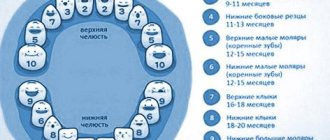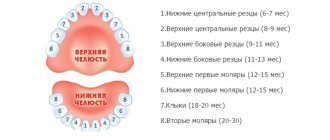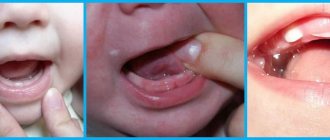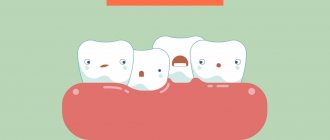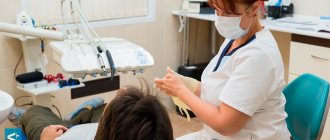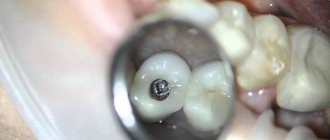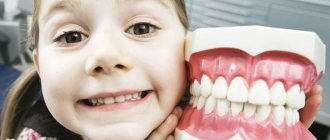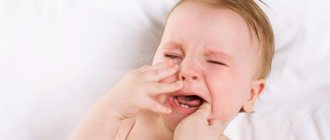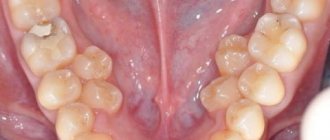Is it normal for babies to have a teething fever?
When teething, your baby may actually develop a fever. When a tooth moves inside the gum, its tissue is injured. The child is in pain and is nervous. And since the baby’s thermoregulation mechanisms are not yet perfect, his temperature can rise even in response to stress. Later, when baby teeth are replaced with permanent teeth, the child may also experience discomfort, but his temperature will remain normal.
However, an increase in temperature during teething may also indicate that the child is simply sick. When a baby is teething, his body experiences additional stress, so his immunity is weakened. Sometimes parents attribute a high fever to “teeth,” but at this time it is necessary to treat the viral infection.
Temperature on teeth.
How long can it last? That's the whole question...
My son woke up on Tuesday morning, somewhat calm, sat him down for breakfast - he didn’t eat, I touched him - he seemed hot, they took his temperature - 38, lay there for an hour - and measured all 39. I called the doctor. The pediatrician came, no cough, no snot, fever and that’s it. I saw 4 chewing teeth at once and said they were all cutting together at once and would come out by Friday. And the neck is a little red. She prescribed us Augmentin (an antibiotic) - to prevent laryngitis against the background of teeth, along with Linex for possible diarrhea from taking an antibiotic, Protorgol to prevent a runny nose from starting, Fenistil for a possible allergy to medications, spray Miramistin on the gums (why?), and Viburkol suppositories and smear Baby Doctor on your gums - this is directly from the teeth. I asked - what if the temperature persists? She says that everything will go away with an antibiotic.
But in the end we decided not to give the antibiotic; Linex is not needed in this case. I still don’t have a runny nose, thank God, I don’t need Fenistil either, I don’t understand why Miramistin, and my son won’t even let us look at his mouth in any case, let alone do anything there. In the end, I was left with Viburkol suppositories, but somehow without any effect (and I don’t really believe in homeopathy, to be honest, it never helps me). The temperature yesterday and the day before yesterday did not drop below 37.8 even with Tsefekon suppositories and Nurofen mixture, the mother-in-law raises a panic that these are not teeth, we still have no other symptoms of anything (well, maybe only the voice sometimes gets a little hoarse if the child screams for something -demanding). Yesterday, rushing around the apartment with my husband in a panic at night (temperature 39), I put in Cefekon and gave Nurofen almost immediately - the temperature subsided (but I was scolded by a pediatrician friend). The result is that a child with a normal temperature woke up shortly after a night’s sleep (though he fell asleep only at 3 am with a fight, but that’s another epic). Now he’s sitting watching cartoons, his temperature is normal for now.
It’s just that if now the temperature suddenly rises again, I’m probably too late to call the pediatrician today. and what should I tell her? I called you, but did not treat the child as you said. Why did you call then? It’s just a shame... But even for prophylaxis, giving an antibiotic is somehow too much. In general, I’m sitting here reproaching myself, what kind of mother is she... A sick child, and what the hell am I doing...
Dear girls, scold me, calm me down, tell me how you cut your teeth? What was the temperature, for how long, what did the doctors prescribe, how did you cope? So the child is cheerful, even with a fever, plays and runs around the apartment. Just more moody, and sometimes looks sick when he’s tired. He has a great appetite, drinks a lot, and pees a lot too)
Methods for reducing temperature
To reduce fever in young children, you can only use drugs based on paracetomol or ibuprofen in the form of syrups and suppositories. Tablets are not given to children under 3 years of age, as it is difficult to correctly calculate the dosage of the medicine.
When the temperature is high, the child needs to be given water often. Warm water, fruit drinks and compotes without sugar, and children's tea with rose hips are suitable. If the child is breastfeeding, continue breastfeeding as required and supplement between feedings.
The room of a sick child must be regularly ventilated and the air humidity in it must be at least 40%. To do this, you can use humidifiers or at least hang wet towels. The room temperature should not be higher than 18-20 ℃.
Thus:
- Temperature during teething in babies of the first year of life, one year and older is normal if other reasons for its increase are excluded.
- During teething, the temperature lasts an average of 1-3 days.
- Temperatures above 38.5 ℃ should be alarming, since during teething it increases by only half a degree.
- Temperatures above 38.5 ℃ should be brought down. If the child is capricious and does not feel well, then an antipyretic can be given at a lower temperature.
- The temperature of young children is brought down with paracetamol and ibuprofen in the form of syrups and suppositories. The room where the child is located must be regularly ventilated, wet cleaned, and ensure normal humidity and temperature. A sick child should be provided with rest and plenty of warm drinks.
(0 ratings; article rating 0)
Share Share Share
Teething symptoms
A child's first teeth begin to erupt between 4 and 8 months. There are exceptions. Sometimes children are born with several teeth, while others show them only after a year. Teething is a difficult process for a child. It can be accompanied by various symptoms, but the most common are the following:
- How long does it take for drugs to leave the body?
- Increased nervousness. The child cries for no reason, whines. Teething may be accompanied by painful sensations that prevent him from sleeping normally. As a result, the regime of wakefulness and rest is disrupted.
- Heavy salivation. This is a protective process. Saliva has anti-inflammatory and bactericidal properties. Hypersalivation helps protect inflamed gums from infection. Sometimes there is so much saliva that it flows down the chin onto the neck and chest. You should not constantly rub your baby's delicate skin. It is permissible to periodically carefully blot with dry wipes.
- Loose stools. During teething, the baby may experience diarrhea. It is caused by increased salivation, changes in intestinal microflora, or increased bacterial activity due to a decrease in the body's immune defense.
- Decreased appetite. Often, due to pain in the gums, infants refuse to eat. In this case, it is a little easier for those who are breastfed, since the sucking process calms and pacifies the baby.
- Inflammation of the gums. This is the natural state of affairs at the time of teething. If a white stripe appears in some place of the gum, the tooth will soon come out.
- Runny nose. Sometimes swelling and inflammation from the gums spreads to the nasal mucosa. As a result, the baby begins to snot.
- Itching in the gums. The baby puts all the objects that come to hand into his mouth. This is how he scratches his gums. To make his task easier, you can purchase special teething toys in stores.
- Hyperthermia. The temperature rises in 80% of cases. It is important to ensure that it does not reach critical levels. Once every 1-2 hours, it is recommended to measure it not with an electronic, but with a mercury thermometer, since it is more reliable.
All these symptoms frighten parents, as they are similar to the signs of many other diseases of the upper respiratory tract and gastrointestinal tract. These symptoms are typical for teething. But you need to monitor the baby’s condition very carefully, and if the clinic is accompanied by other alarming symptoms, you need to immediately contact your doctor.
Symptoms indicating pathology
An increase in temperature during teething is a natural process. This is a kind of protective reaction of the baby’s body. At this time, it is necessary to carefully assess the general condition of the child. Sometimes dangerous pathologies can be hidden behind teething syndrome. Therefore, parents should know the symptoms indicating the progression of the pathological process:
- Vomit. Single vomiting can occur at high temperatures. But if it recurs, the baby feels very bad and has diarrhea, you need to see a doctor as soon as possible. These are signs of intestinal infection or poisoning.
- Nasal congestion or discharge of thick yellow-green snot. This is not the norm, it is a pathology that requires adequate and immediate treatment.
- Coughing. During teething, a lot of saliva is released. Often children simply do not have time to swallow it, and they may choke. A cough appears reflexively, which is not pathological. But if wheezing is heard and a certain amount of sputum is released during coughing, this indicates the development of diseases of the upper respiratory tract (tracheitis, bronchitis and others).
- Stomach ache. With normal teething, this symptom should be absent. If the baby is restless, capricious, cries, or pulls his legs toward his stomach, these are alarming signs. Especially if the abdominal pain is accompanied by repeated vomiting. This symptom complex indicates the development of an intestinal infection. The child could pick it up through toys and other objects that he pulled into his mouth.
- Red throat. Swelling from the gums does not spread to the palate. It can spread to the nasal cavity. If the throat and palate are hyperemic (reddened) upon examination, this is the first sign of the development of pharyngitis.
If you have at least one of these symptoms, you should immediately contact your doctor or go to a medical facility. There the child will be examined by a pediatrician and prescribed the correct treatment. It is prohibited to give any medications (except antipyretics) at home without prior approval from the doctor.
How long can an elevated body temperature remain?
There is no clear answer to this question. It all depends on the health of the baby. As for the results of long-term observations, on average, the increased body temperature of a child during the formation of baby teeth persists for one to three days. It is important to note that when the top of the tooth appears above the surface of the gum, body temperature returns to normal. This happens as each tooth erupts.
However, statistics show that in some children, elevated body temperature persists for four or even five days, and the fever can last only a few hours and go away on its own.
Knowing all of the above does not mean that parents should not show their baby to pediatricians. An extra examination by a specialist will never hurt, but, on the contrary, will help identify diseases at the earliest stage of their development.
What should you be wary of besides a very high temperature?
Since the formation of a child’s chewing apparatus is not without problems, there is a risk that the baby, against the background of the body’s low resistance to disease, may contract viral or bacterial infections. The symptoms of teething may hide more serious illnesses. Therefore, you should pay attention to the following:
- Loose and frequent stools. Fever and intestinal upset along with the appearance of teeth together are extremely rare. Therefore, these may be manifestations of an intestinal infection (enteritis, dysbacteriosis), which the child brought into the body through the mouth on gum toys.
- Vomiting in young children is often accompanied by elevated body temperature. But in this case, it is worth excluding serious damage to the nervous system or housing and communal services disorder.
- Excessive nasal congestion, with copious purulent discharge observed, may be a manifestation of the fact that rhinitis, adenoiditis, etc., which require long-term treatment, is layered on top of the swelling of the nasal mucosa.
- Redness of the throat. Inflammation of the gums during the eruption of baby teeth does not cause the same inflammatory processes on the mucous membrane of the child’s neck. Therefore, reddened palatine arches or pharynx can be signs of ARVI, tonsillitis, pharyngitis, or another infection.
- Cough. With excessive dental drooling, the child does not have time to swallow saliva and sometimes chokes and coughs. But if the cough has become frequent against the background of sputum and obvious difficulty breathing, then this may be a symptom of respiratory tract diseases, for example, laryngotracheitis or bronchitis.
We also cannot exclude stomatitis, which occurs because the child wants to relieve the itching of the gums, so he pulls all solid objects into his mouth, which introduces pathogenic bacteria to the oral mucosa. ATTENTION! An increase in body temperature when baby teeth fall out and permanent teeth appear should alert you. Because replacing a set of baby teeth with molars, as a rule, does not cause a temperature reaction in the child’s body. An exception may be chewing teeth (premolars and molars), which have a large surface, which causes unhealthy reactions in the gum tissue. But for the most part, temperature when changing teeth in a child 6 years old or more can be a manifestation of gingivitis - inflammation of the gingival mucosa.
